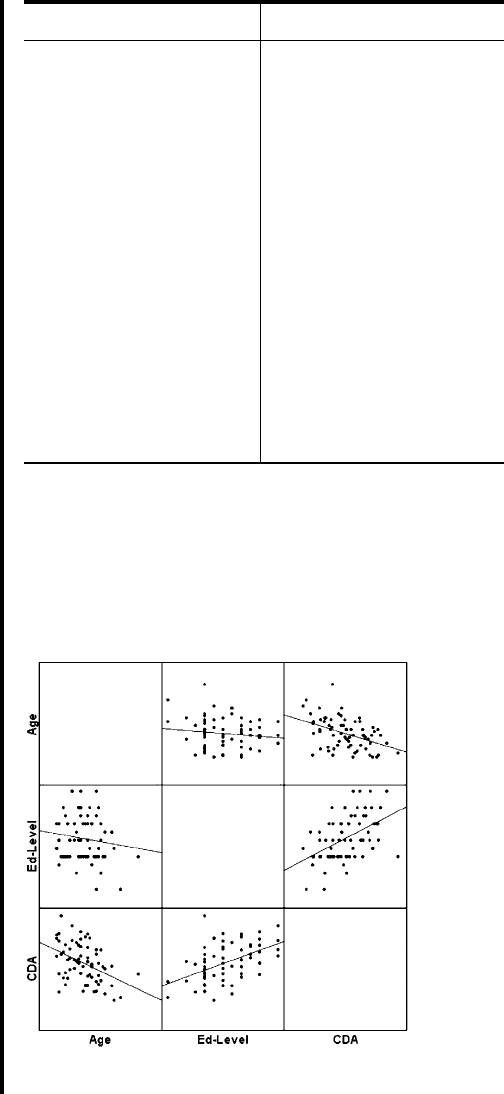Daniel W.W. Biostatistics: A Foundation for Analysis in the Health Sciences
Подождите немного. Документ загружается.

Assumptions The assumptions underlying multiple regression analysis are as
follows.
1. The are nonrandom (fixed) variables. This assumption distinguishes the multi-
ple regression model from the multiple correlation model, which will be presented
in Section 10.6. This condition indicates that any inferences that are drawn from
sample data apply only to the set of X values observed and not to some larger col-
lection of X’s. Under the regression model, correlation analysis is not meaningful.
Under the correlation model to be presented later, the regression techniques that
follow may be applied.
2. For each set of values there is a subpopulation of Y values. To construct certain
confidence intervals and test hypotheses, it must be known, or the researcher must
be willing to assume, that these subpopulations of Y values are normally distributed.
Since we will want to demonstrate these inferential procedures, the assumption of
normality will be made in the examples and exercises in this chapter.
3. The variances of the subpopulations of Y are all equal.
4. The Y values are independent. That is, the values of Y selected for one set of X
values do not depend on the values of Y selected at another set of X values.
The Model Equation The assumptions for multiple regression analysis may be
stated in more compact fashion as
(10.2.1)
where is a typical value from one of the subpopulations of Y values; the are called
the regression coefficients; are, respectively, particular values of the inde-
pendent variables and is a random variable with mean 0 and variance
the common variance of the subpopulations of Y values. To construct confidence
intervals for and test hypotheses about the regression coefficients, we assume that the
are normally and independently distributed. The statements regarding are a conse-
quence of the assumptions regarding the distributions of Y values. We will refer to Equa-
tion 10.2.1 as the multiple linear regression model.
When Equation 10.2.1 consists of one dependent variable and two independent
variables, that is, when the model is written
(10.2.2)
a plane in three-dimensional space may be fitted to the data points as illustrated in Fig-
ure 10.2.1. When the model contains more than two independent variables, it is described
geometrically as a hyperplane.
In Figure 10.2.1 the observer should visualize some of the points as being located
above the plane and some as being located below the plane. The deviation of a point
from the plane is represented by
(10.2.3)
In Equation 10.2.2, represents the point where the plane cuts the Y-axis; that
is, it represents the Y-intercept of the plane. measures the average change in Y for ab
1
b
0
P
j
= y
j
- b
0
- b
1
x
1j
- b
2
x
2j
y
j
= b
0
+ b
1
x
1j
+ b
2
x
2j
+P
j
P
j
P
j
s
2
,
P
j
X
1
, X
2
, Á X
k
;
x
1j
, x
2j
, Á , x
kj
b
i
y
j
y
j
= b
0
+ b
1
x
1j
+ b
2
x
2j
+
...
+ b
k
x
kj
+P
j
X
i
X
i
10.2 THE MULTIPLE LINEAR REGRESSION MODEL
487

unit change in when remains unchanged, and measures the average change in
Y for a unit change in when remains unchanged. For this reason and are
referred to as partial regression coefficients.
10.3 OBTAINING THE MULTIPLE
REGRESSION EQUATION
Unbiased estimates of the parameters of the model specified in Equation
10.2.1 are obtained by the method of least squares. This means that the sum of the
squared deviations of the observed values of Y from the resulting regression surface is
minimized. In the three-variable case, as illustrated in Figure 10.2.1, the sum of the
squared deviations of the observations from the plane are a minimum when and
are estimated by the method of least squares. In other words, by the method of least
squares, sample estimates of are selected in such a way that the quantity
is minimized. This quantity, referred to as the sum of squares of the residuals, may also
be written as
(10.3.1)
indicating the fact that the sum of squares of deviations of the observed values of Y from
the values of Y calculated from the estimated equation is minimized.
gP
j
2
= g1y
j
- yN
j
2
2
gP
2
j
= g1y
j
- b
0
- b
1
x
1j
- b
2
x
2j
-
...
- b
k
x
kj
2
2
b
0
, b
1
, . . . , b
k
b
2
b
0
, b
1
,
b
0
, b
1
, . . . , b
k
b
2
b
1
X
1
X
2
b
2
X
2
X
1
488 CHAPTER 10 MULTIPLE REGRESSION AND CORRELATION
Y
X
2
X
1
Deviations from the
plane
Regression plane
FIGURE 10.2.1 Multiple regression plane and scatter of points.

Estimates of the multiple regression parameters may be obtained by means of arith-
metic calculations performed on a handheld calculator. This method of obtaining the esti-
mates is tedious, time-consuming, subject to errors, and a waste of time when a computer is
available. Those interested in examining or using the arithmetic approach may consult ear-
lier editions of this text or those by Snedecor and Cochran (1) and Steel and Torrie (2), who
give numerical examples for four variables, and Anderson and Bancroft (3), who illustrate
the calculations involved when there are five variables. In the following example we use SPSS
software to illustrate an interesting graphical summary of sample data collected on three vari-
ables. We then use MINITAB to illustrate the application of multiple regression analysis.
EXAMPLE 10.3.1
Researchers Jansen and Keller (A-1) used age and education level to predict the capac-
ity to direct attention (CDA) in elderly subjects. CDA refers to neural inhibitory mech-
anisms that focus the mind on what is meaningful while blocking out distractions. The
study collected information on 71 community-dwelling older women with normal men-
tal status. The CDA measurement was calculated from results on standard visual and
auditory measures requiring the inhibition of competing and distracting stimuli. In this
study, CDA scores ranged from to 9.61 with higher scores corresponding with
better attentional functioning. The measurements on CDA, age in years, and education
level (years of schooling) for 71 subjects are shown in Table 10.3.1. We wish to obtain
the sample multiple regression equation.
-7.65
10.3 OBTAINING THE MULTIPLE REGRESSION EQUATION 489
(
Continued
)
TABLE 10.3.1 CDA Scores, Age, and Education Level
for 71 Subjects Described in Example 10.3.1
Age Ed-Level CDA Age Ed-Level CDA
72 20 4.57 79 12 3.17
68 12 3.04 87 12 1.19
65 13 1.39 71 14 0.99
85 14 3.55 81 16 2.94
84 13 2.56 66 16 2.21
90 15 4.66 81 16 0.75
79 12 2.70 80 13 5.07
74 10 0.30 82 12 5.86
69 12 4.46 65 13 5.00
87 15 6.29 73 16 0.63
84 12 4.43 85 16 2.62
79 12 0.18 83 17 1.77
71 12 1.37 83 8 3.79
76 14 3.26 76 20 1.44
73 14 1.12 77 12 5.77
86 12 0.77 83 12 5.77
69 17 3.73 79 14 4.62
66 11 5.92 69 12 2.03
65 16 5.74 66 14 2.22

Prior to analyzing the data using multiple regression techniques, it is useful to con-
struct plots of the relationships among the variables. This is accomplished by making
separate plots of each pair of variables, (X1, X2), (X1, Y), and (X2, Y ). A software pack-
age such as SPSS displays each combination simultaneously in a matrix format as
shown in Figure 10.3.1. From this figure it is apparent that we should expect a negative
490
CHAPTER 10 MULTIPLE REGRESSION AND CORRELATION
Age Ed-Level CDA Age Ed-Level CDA
71 14 2.83 75 12 0.80
80 18 2.40 77 16 0.75
81 11 0.29 78 12 4.60
66 14 4.44 83 20 2.68
76 17 3.35 85 10 3.69
70 12 3.13 76 18 4.85
76 12 2.14 75 14 0.08
67 12 9.61 70 16 0.63
72 20 7.57 79 16 5.92
68 18 2.21 75 18 3.63
102 12 2.30 94 8 7.07
67 12 1.73 76 18 6.39
66 14 6.03 84 18 0.08
75 18 0.02 79 17 1.07
91 13 7.65 78 16 5.31
74 15 4.17 79 12 0.30
90 15 0.68
Source: Debra A. Jansen, Ph.D., R.N. Used with permission.
FIGURE 10.3.1 SPSS matrix scatter plot of the
data in Table 10.3.1.

10.3 OBTAINING THE MULTIPLE REGRESSION EQUATION 491
Dialog box: Session command:
Stat ➤ Regression ➤ Regression MTB > Name C4 = `SRES1’
Type Y in Response and X1 X2 C5 = `FITS1’ C6 = `RESI1’
in Predictors. MTB > Regress `y’ 2 `x1’ `x2’;
Check Residuals. SUBC> SResiduals `SRES1’;
Check Standard resids. SUBC> Fits `FITS1’;
Check OK. SUBC> Constant;
SUBC> Residuals `RESI1’.
Output:
Regression Analysis: Y versus X1, X2
The regression equation is
Y = 5.49 - 0.184 X1 + 0.611 X2
Predictor Coef SE Coef T P
Constant 5.494 4.443 1.24 0.220
X1 -0.18412 0.04851 -3.80 0.000
X2 0.6108 0.1357 4.50 0.000
S = 3.134 R-Sq = 37.1% R-Sq (adj) = 35.2%
Analysis of Variance
Source DF SS MS F P
Regression 2 393.39 196.69 20.02 0.000
Residual Error 68 667.97 9.82
Total 70 1061.36
Source DF Seq SS
X1 1 194.24
X2 1 199.15
Unusual Observations
Obs X1 Y Fit SE Fit Residual St Resid
28 67 9.610 0.487 0.707 9.123 2.99R
31 102 -2.300 -5.957 1.268 3.657 1.28X
44 80 5.070 -1.296 0.425 6.366 2.05R
67 94 -7.070 -6.927 1.159 -0.143 -0.05X
R denotes an observation with a large standardized residual.
X denotes an observation whose X value gives it large influence.
FIGURE 10.3.2 MINITAB procedure and output for Example 10.3.1.

492 CHAPTER 10 MULTIPLE REGRESSION AND CORRELATION
The REG Procedure
Model: MODEL1
Dependent Variable: CDA
Analysis of Variance
Sum of Mean
Source DF Squares Square F Value Pr > F
Model 2 393.38832 196.69416 20.02 <.0001
Error 68 667.97084 9.82310
Corrected Total 70 1061.35915
Root MSE 3.13418 R-Square 0.3706
Dependent Mean 0.00676 Adj R-Sq 0.3521
Coeff Var 46360
Parameter Estimates
Parameter Standard
Variable DF Estimate Error t Value Pr > |t|
Intercept 1 5.49407 4.44297 1.24 0.2205
AGE 1 -0.18412 0.04851 -3.80 0.0003
EDUC 1 0.61078 0.13565 4.50 <.0001
FIGURE 10.3.3 SAS
®
output for Example 10.3.1.
relationship between CDA and Age and a positive relationship between CDA and Ed-
Level. We shall see that this is indeed the case when we use MINITAB to analyze the
data.
Solution: We enter the observations on age, education level, and CDA in c1 through
c3 and name them X1, X2, and Y, respectively. The MINITAB dialog box
and session command, as well as the output, are shown in Figure 10.3.2.
We see from the output that the sample multiple regression equation, in the
notation of Section 10.2, is
Other output entries will be discussed in the sections that follow.
The SAS output for Example 10.3.1 is shown in Figure 10.3.3. ■
After the multiple regression equation has been obtained, the next step involves its
evaluation and interpretation. We cover this facet of the analysis in the next section.
yN
j
= 5.49 - .184x
1j
+ .611x
2j

EXERCISES
Obtain the regression equation for each of the following data sets.
10.3.1 Machiel Naeije (A-2) studied the relationship between maximum mouth opening and measurements
of the lower jaw (mandible). He measured the dependent variable, maximum mouth opening (MMO,
measured in mm), as well as predictor variables, mandibular length (ML, measured in mm) and
angle of rotation of the mandible (RA, measured in degrees) of 35 subjects.
MMO (Y) ML (X
1
) RA (X
2
) MMO (Y) ML (X
1
) RA (X
2
)
52.34 100.85 32.08 50.82 90.65 38.33
51.90 93.08 39.21 40.48 92.99 25.93
52.80 98.43 33.74 59.68 108.97 36.78
50.29 102.95 34.19 54.35 91.85 42.02
57.79 108.24 35.13 47.00 104.30 27.20
49.41 98.34 30.92 47.23 93.16 31.37
53.28 95.57 37.71 41.19 94.18 27.87
59.71 98.85 44.71 42.76 89.56 28.69
53.32 98.32 33.17 51.88 105.85 31.04
48.53 92.70 31.74 42.77 89.29 32.78
51.59 88.89 37.07 52.34 92.58 37.82
58.52 104.06 38.71 50.45 98.64 33.36
62.93 98.18 43.89 43.18 83.70 31.93
57.62 91.01 41.06 41.99 88.46 28.32
65.64 96.98 41.92 39.45 94.93 24.82
52.85 97.85 35.25 38.91 96.81 23.88
64.43 96.89 45.11 49.10 93.13 36.17
57.25 98.35 39.44
Source: M. Naeije, D.D.S. Used with permission.
10.3.2 Family caregiving of older adults is more common in Korea than in the United States. Son et al.
(A-3) studied 100 caregivers of older adults with dementia in Seoul, South Korea. The dependent
variable was caregiver burden as measured by the Korean Burden Inventory (KBI). Scores ranged
from 28 to 140, with higher scores indicating higher burden. Explanatory variables were indexes
that measured the following:
ADL: total activities of daily living (low scores indicate that the elderly perform activities
independently).
MEM: memory and behavioral problems (higher scores indicate more problems).
COG: cognitive impairment (lower scores indicate a greater degree of cognitive impairment).
The reported data are as follows:
KBI (Y ) ADL (X
1
) MEM (X
2
) COG (X
3
) KBI (Y) ADL (X
1
) MEM (X
2
) COG (X
3
)
28 39 4 18 88 76 50 5
68 52 33 9 54 79 44 11
59 89 17 3 73 48 57 9
91 57 31 7 87 90 33 6
EXERCISES 493
(Continued)

KBI (Y ) ADL (X
1
) MEM (X
2
) COG (X
3
) KBI (Y) ADL (X
1
) MEM (X
2
) COG (X
3
)
70 28 35 19 47 55 11 20
38 34 3 25 60 83 24 11
46 42 16 17 65 50 21 25
57 52 6 26 57 44 31 18
89 88 41 13 85 79 30 20
48 90 24 3 28 24 5 22
74 38 22 13 40 40 20 17
78 83 41 11 87 35 15 27
43 30 9 24 80 55 9 21
76 45 33 14 49 45 28 17
72 47 36 18 57 46 19 17
61 90 17 0 32 37 4 21
63 63 14 16 52 47 29 3
77 34 35 22 42 28 23 21
85 76 33 23 49 61 8 7
31 26 13 18 63 35 31 26
79 68 34 26 89 68 65 6
92 85 28 10 67 80 29 10
76 22 12 16 43 43 8 13
91 82 57 3 47 53 14 18
78 80 51 3 70 60 30 16
103 80 20 18 99 63 22 18
99 81 20 1 53 28 9 27
73 30 7 17 78 35 18 14
88 27 27 27 112 37 33 17
64 72 9 0 52 82 25 13
52 46 15 22 68 88 16 0
71 63 52 13 63 52 15 0
41 45 26 18 49 30 16 18
85 77 57 0 42 69 49 12
52 42 10 19 56 52 17 20
68 60 34 11 46 59 38 17
57 33 14 14 72 53 22 21
84 49 30 15 95 65 56 2
91 89 64 0 57 90 12 0
83 72 31 3 88 88 42 6
73 45 24 19 81 66 12 23
57 73 13 3 104 60 21 7
69 58 16 15 88 48 14 13
81 33 17 21 115 82 41 13
71 34 13 18 66 88 24 14
91 90 42 6 92 63 49 5
48 48 7 23 97 79 34 3
94 47 17 18 69 71 38 17
57 32 13 15 112 66 48 13
49 63 32 15 88 81 66 1
Source: Gwi-Ryung Son, R.N., Ph.D. Used with permission.
494 CHAPTER 10 MULTIPLE REGRESSION AND CORRELATION

10.3.3 In a study of factors thought to be related to patterns of admission to a large general hospital, an
administrator obtained these data on 10 communities in the hospital’s catchment area:
Index of
Persons per 1000 Availability of
Population Admitted Other Health Index of
During Study Period Services Indigency
Community (Y)(X
1
)(X
2
)
1 61.6 6.0 6.3
2 53.2 4.4 5.5
3 65.5 9.1 3.6
4 64.9 8.1 5.8
5 72.7 9.7 6.8
6 52.2 4.8 7.9
7 50.2 7.6 4.2
8 44.0 4.4 6.0
9 53.8 9.1 2.8
10 53.5 6.7 6.7
Total 571.6 69.9 55.6
10.3.4 The administrator of a general hospital obtained the following data on 20 surgery patients during
a study to determine what factors appear to be related to length of stay:
Postoperative Preoperative
Length of Number of Current Length of
Stay in Days Medical Problems Stay in Days
(Y)(X
1
)(X
2
)
611
621
11 2 2
913
16 3 3
16 1 5
411
831
11 2 2
13 3 2
13 1 4
912
17 3 3
17 2 4
12 4 1
611
511
EXERCISES 495
(Continued)

Postoperative Preoperative
Length of Number of Current Length of
Stay in Days Medical Problems Stay in Days
(Y)(X
1
)(X
2
)
12 3 2
812
922
Total 208 38 43
10.3.5 A random sample of 25 nurses selected from a state registry yielded the following information on
each nurse’s score on the state board examination and his or her final score in school. Both scores
relate to the nurse’s area of affiliation. Additional information on the score made by each nurse
on an aptitude test, taken at the time of entering nursing school, was made available to the
researcher. The complete data are as follows:
State Board Score Final Score Aptitude Test Score
(Y )(X
1
)(X
2
)
440 87 92
480 87 79
535 87 99
460 88 91
525 88 84
480 89 71
510 89 78
530 89 78
545 89 71
600 89 76
495 90 89
545 90 90
575 90 73
525 91 71
575 91 81
600 91 84
490 92 70
510 92 85
575 92 71
540 93 76
595 93 90
525 94 94
545 94 94
600 94 93
625 94 73
Total 13,425 2263 2053
496 CHAPTER 10 MULTIPLE REGRESSION AND CORRELATION
